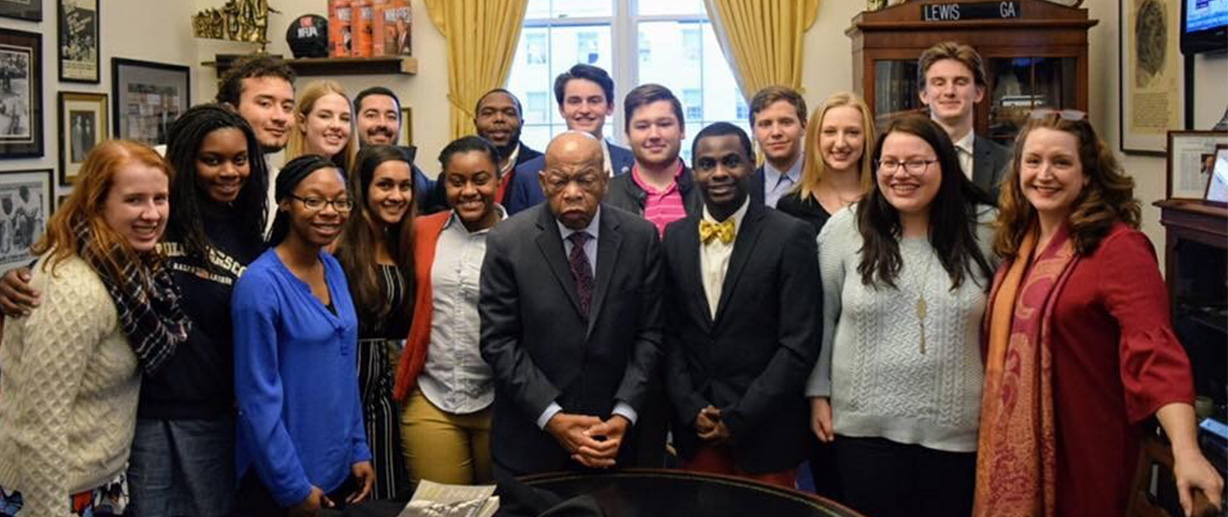SPARTANBURG, S.C. — The first time he saw U.S. Rep. John Lewis in person, James Stukes learned the truth about giants.
Giants come in all sizes.
“It was a surreal moment,” says Stukes, the coordinator for college access and student success who helped lead a group of first-year Bonner Scholars and other Wofford students on trips to Washington, D.C., during Interim in 2018 and 2019. “We were in his office, and it was my first time being in the Capitol. He walked in and the first thing that struck me was seeing in the flesh how small (5-foot-6) he was, but realizing what a huge legacy he had built.”
Lewis, who represented Georgia in Congress from 1987 until his death in July, was a key figure, along with Martin Luther King Jr., in the civil rights movement that sought to end segregation. He was one of the leaders who helped organize the 1963 March on Washington, and led a march from Selma to Montgomery, Alabama, that resulted in state troopers and police attacking marchers, including Lewis, on the Edmund Pettus Bridge.
Lewis spoke to visitors from Wofford on several occasions. Sarah Hager, a 2011 graduate from Rock Hill, South Carolina, worked in Lewis’ office and helped organize the congressman’s meetings with the Wofford groups. Hager is now a senior communications associate with the American Federation of Teachers in the district.
“This may sound off since it is a professional workplace, but his office was like family,” Hager says. “Really, hardly anyone left and hardly anyone new was hired. So, because of that, we were all very close. You can only do so much to ‘demand’ the congressman take such and such meeting, but I explained to him and his scheduler how important it was to meet with a group of students from Wofford as often as possible. He was familiar with Bonner Scholars and was happy to do so. He was inspired by their leadership and interest in the world.”
Jessalyn Story, the director of the Center for Community-Based Learning, has led numerous trips to the capitol. Like Stukes, she says it was an emotional scene the first time she met Lewis, which was in 2017, days before President Donald Trump’s inauguration.
Story says Lewis told the group about growing up in Alabama as the son of sharecroppers, and how his parents feared for his safety as he was growing up. He told them about getting into “good trouble,” and encouraged them to get in the way if they saw something wrong.
“One of the many things that struck me about each of the three visits with him was how generous he was with his time, even with students from a school three hours away from his district,” Story says. “He knew well – had deeply lived it – the importance of instilling democratic values and civic-mindedness in future generations, and he did that very, very well. The 50 or so Wofford students who had the opportunity to spend time with him and learn from him over the years and I will carry that memory with us and be inspired by it for the rest of our lives.”
There was no trip this month because of the ongoing COVID-19 pandemic. There are hopes that a trip will be held later this year. Story and Stukes, though, don’t know who can fill the void left by Lewis’ death.
For Hager, no one can. She first met Lewis at the home of Medgar Evers, another pioneer of the civil rights movement who was shot and killed by a white supremacist in 1963, and worked for him for five years.
“My life’s biggest lessons will always be from him,” she says. “He taught me perseverance in the face of adversity, patience, kindness, forgiveness but accountability. And more than all of that he taught me that despite the world's woes, you can always make time for fun. Activism is a lifetime's calling and you must never give up or give in. We're all in this thing together, trying to create what Dr. King called the Beloved Community. It's not the work of a day or a week, but a lifetime.”
